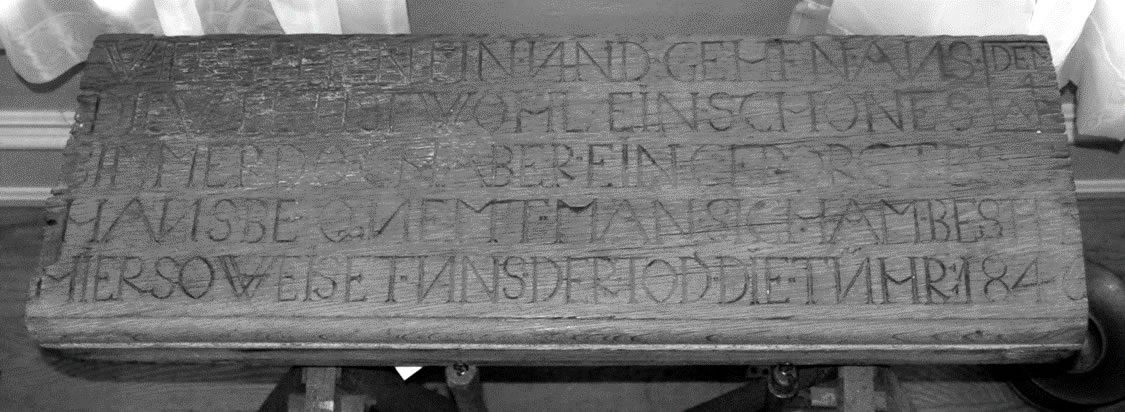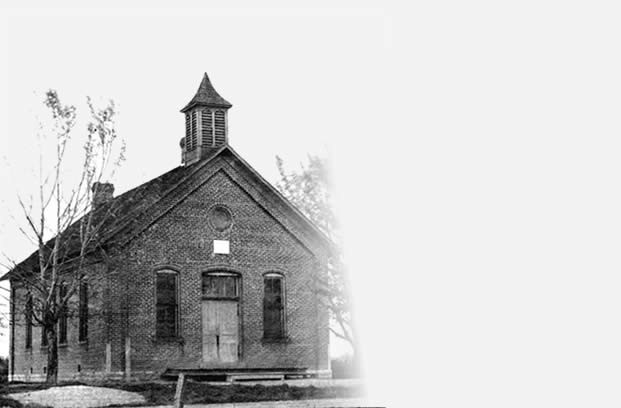The inscribed oak slab featured in this article is displayed by the New Knoxville Historical Society in the Dr. H. E. Fledderjohann house at the Heritage Center.
104-Year Old Inscription Uncovered In Home Near New Knoxville Where Five Died of Cholera Within Short Time During epidemic of Years Ago
By Andrew Kay (Published January 28, 1950)

1846 Hand Carved Inscription
Above is pictured the unique and what might be termed a prophetic inscription slab which carpenters uncovered while remodeling the 104 year old “Cemetery Meckstroth” house, a mile and a half West of New Knoxville, and just West of Pilger Ruhe Cemetery, in which 5 people died of cholera.
The 3-1/4 feet long, 12 inches wide and 5-1/2 inches thick solid Oak slab is in an excellent state of preservation after 104 years, and is on display in the window of The Evening Leader. Carved, (literally chiseled), thereon is the following inscription, in German:
“Wir gehen ein und gehen aus
Die Welt ist wohl ein schones Zimmer
Doch aber ein geborgtes Haus.
Bequemt man sich am besten hier,
So weiset uns der Tod die Tuhr.“
April 4, 1846
Literally translated, with no attempt at making rhymes, it means something like this:
“We (at this house) go in and out
The world is indeed a pleasant room.
But it is also a borrowed house
And if we make ourselves too
comfortable here
Then death shows the door.”
April 4, 1846
The at least 104 year old farm home is the property of Mr. and Mrs. Lawrence Meckstroth. They are having it remodeled by the carpenter team of Albert P. Rodeheffer and his son Carl Rodeheffer. While cutting out siding in the process of making a door in the south side of the house, they came upon the heavy Oak slab pictured above. The inscription suffered but little damage before discovery. After the inscription was discovered the slab was apparently treated with far more tender care than its rugged and time tested sturdiness required. Harold “Chic” Howe had informed us of the discovery.
Going there Monday morning we found Lawrence Meckstroth and the carpenter team hard at work. We asked Albert Rodeheffer (from whom we bought a motorcycle a “few” years ago—a Thor-belt drive—when Andrew Kay was a brush salesman during summer vacation while in college) concerning the find. He referred me to the owner, Mr. Meckstroth. Mr. Meckstroth, who was in a joshing good mood, said, “O that? It made wonderful firewood!” I said, “Oh! Did you burn it?”—evidently with an inflection indicating dismay. “No, I certainly didn’t,” he answered laughing as he led the way to the summer kitchen where it was in safe keeping, and what’s more, we are planning to have the slab imbedded in the wall of our remodeled house, probably above the door.” The carving thereon is so artistic that they feel it would not only make an artistically carved curiosity in the nature of a “young antique”, but that the sentiment inscribed thereon is likewise a healthy reminder of the transiency of life.
The inscription proved timely for the original inhabitants of that house. During the cholera epidemic soon thereafter, 5 members of the family died in that house within the space of a few days. The first to go was Mrs. Herman W. Fledderjohn, age 23, mother of 3 children. Two days later, both her husband and his father, H. W. Fledderjohn, died, her husband at the age of 24, his father 63. Next to go was his son, age 4, and then his mother, age 67. Surviving the 5 were their 2 little children, Elizabeth, age 3, and Frederick age 1-1/2 years, both desperately ill with the same sickness. Then it appeared that little Frederick had died, and he was left for dead. But some one who was looking at the supposed lifeless body saw the child gasp for breath, and immediately took care of him again. He not only survived but lived to be over 80 years old, having died Aug. 1, 1928. Little Elizabeth, aged 3, also recovered, grew to maturity and married William Meckstroth. She is the mother of Herman H. Meckstroth who lived there until last June, and so is the grandmother of Lawrence, the present owner. She lived to be over 70.
From George Kattman’s history of New Knoxville we learn that in Ohio the Asiatic cholera apparently followed in the wake of the course of the Miami Erie Canal. It exacted a heavy toll of life among the pioneers, in some instances entire families being wiped out. We went to both of the old cemeteries in the heart of New Knoxville and studied the tombstones. The cholera victims were said to have been laid to rest in the old part of the old cemetery. Whatever markers may have at any time existed all have been obliterated by the time and weather. Very few markers, if any, bear death dates prior to 1860.
Then we called on Dr. H. E. Fledderjohn M. D. for such information as he might be able to give us. “I have never seen any one sick with cholera and I am glad that I never did,” he said. “But from what I was told by older doctors when I first began to practice medicine, the disease was very violent. The victim would get severe cramps, spasms they called it, fearful diarrhea, and had a terrible thirst. Sometimes they would be dead in from 3 to 5 hours.” He told how the shrill sound of a trumpet was the SOS call among the pioneer neighbors, meaning distress and a summons for urgent help. He told of one of his relatives who answered a neighbor’s SOS, and in doing so ran into a cholera afflicted family, took care of their immediate needs, became ill on the way home, and did not live to see the next sunrise. Whether or not that had been his first exposure to disease, he of course did not know.
Research at the St. Marys Library revealed that the cholera crossed the Atlantic from Europe and attacked Montreal and New York City first of all. Ere long it hit Syracuse, New York and spread Westward. Doctors were in complete ignorance as to both cause and cure. Some held it was contracted through toxins coming through leather shoe soles, out of the ground, and so advocated wearing wooden-soled shoes. Others held that it came out of the air, and that night air contained a certain miasma and so was especially conducive to the disease. Accordingly, so called pest-houses, as the quarters housing the afflicted were called, carefully kept their windows closed even in the stifling July and August heat. This made the atmosphere malodorously foul. Barrels and barrels of tar were burned in a futile attempt to purify the supposed poisoned air. Other doctors recommended continuous bonfires. But finally the Erie Canal came to be looked upon as the villain, since the epidemic seemed to be following the course of the canal in New York State. Facts in the matter appear to have been that passenger boats plying the Erie Canal were carrying heavy loads of cheap contract labor from Europe, up the Hudson and through the canal, to western destinations. The pestilence broke out so often among these immigrants that some towns along the canal absolutely refused to let the boats unload. A certain canal boat carried 56 passengers, all immigrants, of whom 5 were dead from cholera upon arrival at Utica, New York, and 14 others were so ill that they died very shortly after being taken to the pest house. And the medical profession disagreed as to whether the disease was contagious or not! According to magazine accounts of the epidemic, doctors tried everything from bleeding and tobacco-juice enemas, to laughing gas and cautery. But along came the first killing frost for the season along the Erie Canal and at once the epidemic abated. A verse that is supposed to have been sung and taught to children in New York State is said to have read:
“The cholera cometh; take care—take care!
Look well to thy dwelling! Beware! Beware!
He breatheth corruption, and loveth the spot,
where offal is suffered to lie and rot;
Then look to thy cellar, thy closet and yard—
For all kinds of filth he hath special regard.
In any case it appeared that frost at least seasonally stopped whatever bug or insects were carriers of the evil germ. But with the coming of the summer heat the disease reappeared and continued its westward way, following the course of the Miami Erie Canal through the State of Ohio and going as far east as Shelby County. But all that was about a century ago, and it was during these days that the above inscription was painstakingly chiseled or carved into the solid oaken slab.
The carpenters working there will not need muscle exercise for their hammer-arms while working there. The wood is thoroughly aged and it takes a person who is well nigh an expert to drive a nail into the time-hardened timbers. Removal of the old plastered ceiling in what is now being made into a spacious living room reveals that the ceilings were originally unplastered and were covered with white-wash. The white-wash still clinging to the underside of the wooden ceiling and the timbers, is believed to be about 70 years old. The century old timbers are not only free from decay, but also of such size and dimensions as will make the remodeled house an exceedingly sturdy one. The oak timbers were hand wrought, bearing the marks of the broad-ax, and considerably larger and stronger than those used in present day construction.
NOTE: This house is located at 06027 New Bremen-New Knoxville Road and is now occupied by Lawrence Meckstroth’s son and daughter-in-law, Dwain and Brenda Meckstroth.
NOTE: When the Pilger Ruhe Cemetery Association was established in 1896, 10 acres of this farm were purchased for the cemetery, thus the name “Cemetery Meckstroth” farm.


